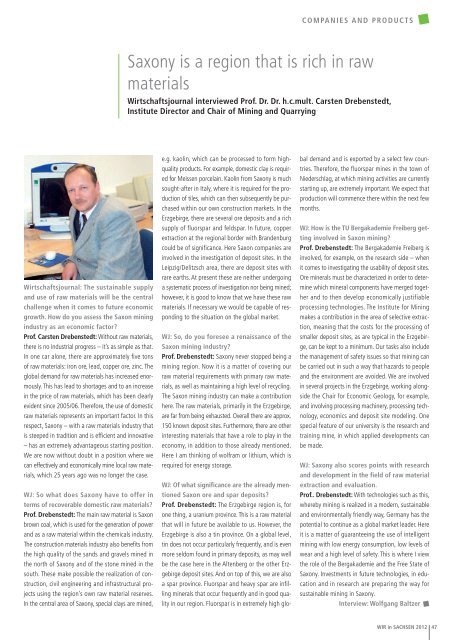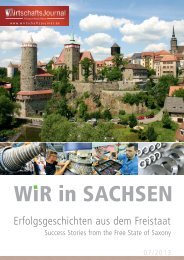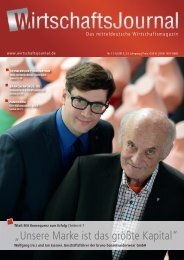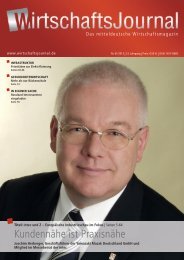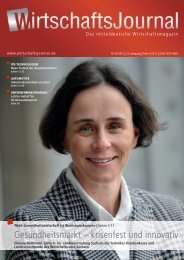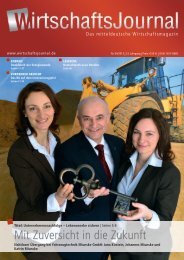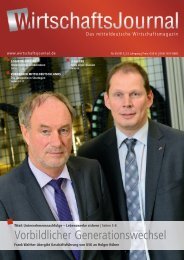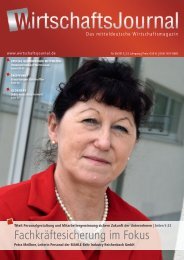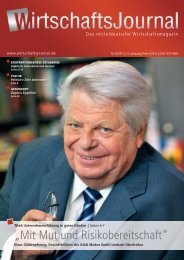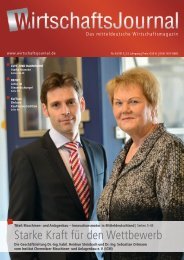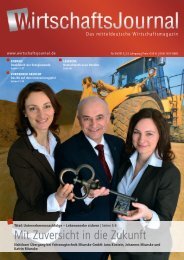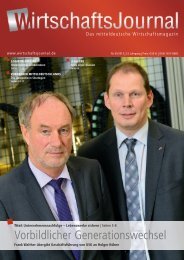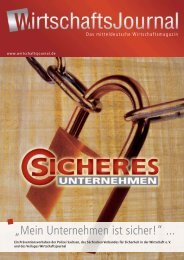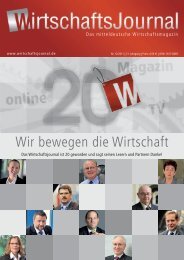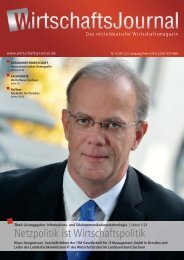Wir in Sachsen 2012 - Wirtschaftsjournal
Wir in Sachsen 2012 - Wirtschaftsjournal
Wir in Sachsen 2012 - Wirtschaftsjournal
Sie wollen auch ein ePaper? Erhöhen Sie die Reichweite Ihrer Titel.
YUMPU macht aus Druck-PDFs automatisch weboptimierte ePaper, die Google liebt.
<strong>Wir</strong>tschaftsjournal: The susta<strong>in</strong>able supply<br />
and use of raw materials will be the central<br />
challenge when it comes to future economic<br />
growth. How do you assess the Saxon m<strong>in</strong><strong>in</strong>g<br />
<strong>in</strong>dustry as an economic factor?<br />
Prof. Carsten Drebenstedt: Without raw ma terials,<br />
there is no <strong>in</strong>dustrial progress – it’s as simple as that.<br />
In one car alone, there are approximately five tons<br />
of raw materials: iron ore, lead, copper ore, z<strong>in</strong>c. The<br />
global demand for raw materials has <strong>in</strong>creased enormously.<br />
This has lead to shortages and to an <strong>in</strong> crease<br />
<strong>in</strong> the price of raw materials, which has been clearly<br />
evident s<strong>in</strong>ce 2005/06. Therefore, the use of domestic<br />
raw materials represents an important factor. In this<br />
respect, Saxony – with a raw materials <strong>in</strong>dustry that<br />
is steeped <strong>in</strong> tradition and is efficient and <strong>in</strong>novative<br />
– has an extremely advantageous start<strong>in</strong>g position.<br />
We are now without doubt <strong>in</strong> a position where we<br />
can effectively and economically m<strong>in</strong>e local raw materials,<br />
which 25 years ago was no longer the case.<br />
WJ: So what does Saxony have to offer <strong>in</strong><br />
terms of recoverable domestic raw materials?<br />
Prof. Drebenstedt: The ma<strong>in</strong> raw material is Saxon<br />
brown coal, which is used for the generation of power<br />
and as a raw material with<strong>in</strong> the chemicals <strong>in</strong>dustry.<br />
The construction materials <strong>in</strong>dustry also benefits from<br />
the high quality of the sands and gravels m<strong>in</strong>ed <strong>in</strong><br />
the north of Saxony and of the stone m<strong>in</strong>ed <strong>in</strong> the<br />
south. These make possible the realization of construction,<br />
civil eng<strong>in</strong>eer<strong>in</strong>g and <strong>in</strong>frastructural projects<br />
us<strong>in</strong>g the region’s own raw material reserves.<br />
In the central area of Saxony, special clays are m<strong>in</strong>ed,<br />
e.g. kaol<strong>in</strong>, which can be processed to form highquality<br />
products. For example, domestic clay is requir -<br />
ed for Meissen porcela<strong>in</strong>. Kaol<strong>in</strong> from Saxony is much<br />
sought-after <strong>in</strong> Italy, where it is required for the production<br />
of tiles, which can then subsequently be purchased<br />
with<strong>in</strong> our own construction markets. In the<br />
Erzgebirge, there are several ore deposits and a rich<br />
supply of fluorspar and feldspar. In future, copper<br />
extraction at the regional border with Brandenburg<br />
could be of significance. Here Saxon companies are<br />
<strong>in</strong>volved <strong>in</strong> the <strong>in</strong>vestigation of deposit sites. In the<br />
Leipzig/Delitzsch area, there are deposit sites with<br />
rare earths. At present these are neither undergo<strong>in</strong>g<br />
a systematic process of <strong>in</strong>vestigation nor be<strong>in</strong>g m<strong>in</strong>ed;<br />
however, it is good to know that we have these raw<br />
materials. If necessary we would be capable of res -<br />
pond<strong>in</strong>g to the situation on the global market.<br />
WJ: So, do you foresee a renaissance of the<br />
Saxon m<strong>in</strong><strong>in</strong>g <strong>in</strong>dustry?<br />
Prof. Drebenstedt: Saxony never stopped be<strong>in</strong>g a<br />
m<strong>in</strong><strong>in</strong>g region. Now it is a matter of cover<strong>in</strong>g our<br />
raw material requirements with primary raw materials,<br />
as well as ma<strong>in</strong>ta<strong>in</strong><strong>in</strong>g a high level of recycl<strong>in</strong>g.<br />
The Saxon m<strong>in</strong><strong>in</strong>g <strong>in</strong>dustry can make a contribution<br />
here. The raw materials, primarily <strong>in</strong> the Erzgebirge,<br />
are far from be<strong>in</strong>g exhausted. Overall there are approx.<br />
150 known deposit sites. Furthermore, there are other<br />
<strong>in</strong>terest<strong>in</strong>g materials that have a role to play <strong>in</strong> the<br />
economy, <strong>in</strong> addition to those already mentioned.<br />
Here I am th<strong>in</strong>k<strong>in</strong>g of wolfram or lithium, which is<br />
required for energy storage.<br />
WJ: Of what significance are the already mentioned<br />
Saxon ore and spar deposits?<br />
Prof. Drebenstedt: The Erzgebirge region is, for<br />
one th<strong>in</strong>g, a uranium prov<strong>in</strong>ce. This is a raw material<br />
that will <strong>in</strong> future be available to us. However, the<br />
Erzgebirge is also a t<strong>in</strong> prov<strong>in</strong>ce. On a global level,<br />
t<strong>in</strong> does not occur particularly frequently, and is even<br />
more seldom found <strong>in</strong> primary deposits, as may well<br />
be the case here <strong>in</strong> the Altenberg or the other Erzgebirge<br />
deposit sites. And on top of this, we are also<br />
a spar prov<strong>in</strong>ce. Fluorspar and heavy spar are <strong>in</strong>fill<strong>in</strong>g<br />
m<strong>in</strong>erals that occur frequently and <strong>in</strong> good quality<br />
<strong>in</strong> our region. Fluorspar is <strong>in</strong> extremely high glo-<br />
C O M PA N I E S A N D P R O D U C T S<br />
Saxony is a region that is rich <strong>in</strong> raw<br />
materials<br />
<strong>Wir</strong>tschaftsjournal <strong>in</strong>terviewed Prof. Dr. Dr. h.c.mult. Carsten Drebenstedt,<br />
Institute Director and Chair of M<strong>in</strong><strong>in</strong>g and Quarry<strong>in</strong>g<br />
bal demand and is exported by a select few countries.<br />
Therefore, the fluorspar m<strong>in</strong>es <strong>in</strong> the town of<br />
Niederschlag, at which m<strong>in</strong><strong>in</strong>g activities are currently<br />
start<strong>in</strong>g up, are extremely important. We expect that<br />
production will commence there with<strong>in</strong> the next few<br />
months.<br />
WJ: How is the TU Bergakademie Freiberg gett<strong>in</strong>g<br />
<strong>in</strong>volved <strong>in</strong> Saxon m<strong>in</strong><strong>in</strong>g?<br />
Prof. Drebenstedt: The Bergakademie Freiberg is<br />
<strong>in</strong>volved, for example, on the research side – when<br />
it comes to <strong>in</strong>vestigat<strong>in</strong>g the usability of deposit sites.<br />
Ore m<strong>in</strong>erals must be characterized <strong>in</strong> order to determ<strong>in</strong>e<br />
which m<strong>in</strong>eral components have merged together<br />
and to then develop economically justifiable<br />
process<strong>in</strong>g technologies. The Institute for M<strong>in</strong><strong>in</strong>g<br />
makes a contribution <strong>in</strong> the area of selective extraction,<br />
mean<strong>in</strong>g that the costs for the process<strong>in</strong>g of<br />
smaller deposit sites, as are typical <strong>in</strong> the Erzgebirge,<br />
can be kept to a m<strong>in</strong>imum. Our tasks also <strong>in</strong> clude<br />
the management of safety issues so that m<strong>in</strong><strong>in</strong>g can<br />
be carried out <strong>in</strong> such a way that hazards to people<br />
and the environment are avoided. We are <strong>in</strong>volved<br />
<strong>in</strong> several projects <strong>in</strong> the Erzgebirge, work<strong>in</strong>g alongside<br />
the Chair for Economic Geology, for example,<br />
and <strong>in</strong>volv<strong>in</strong>g process<strong>in</strong>g mach<strong>in</strong>ery, process<strong>in</strong>g technology,<br />
economics and deposit site model<strong>in</strong>g. One<br />
special feature of our university is the research and<br />
tra<strong>in</strong><strong>in</strong>g m<strong>in</strong>e, <strong>in</strong> which applied developments can<br />
be made.<br />
WJ: Saxony also scores po<strong>in</strong>ts with research<br />
and development <strong>in</strong> the field of raw material<br />
extraction and evaluation.<br />
Prof.. Drebenstedt: With technologies such as this,<br />
whereby m<strong>in</strong><strong>in</strong>g is realized <strong>in</strong> a modern, susta<strong>in</strong>able<br />
and environmentally friendly way, Germany has the<br />
potential to cont<strong>in</strong>ue as a global market leader. Here<br />
it is a matter of guarantee<strong>in</strong>g the use of <strong>in</strong>telligent<br />
m<strong>in</strong><strong>in</strong>g with low energy consumption, low levels of<br />
wear and a high level of safety. This is where I view<br />
the role of the Bergakademie and the Free State of<br />
Saxony. Investments <strong>in</strong> future technologies, <strong>in</strong> education<br />
and <strong>in</strong> research are prepar<strong>in</strong>g the way for<br />
susta<strong>in</strong>able m<strong>in</strong><strong>in</strong>g <strong>in</strong> Saxony.<br />
Interview: Wolfgang Baltzer<br />
WIR <strong>in</strong> SACHSEN <strong>2012</strong> 47


